University Assignment: Critical Appraisal of Review Articles
VerifiedAdded on 2023/01/13
|29
|3432
|48
Report
AI Summary
This report presents a critical appraisal of three review articles focusing on the treatment of ST-segment elevation myocardial infarction (STEMI). The first article, "Reperfusion therapy in the acute management of ST‐segment‐elevation myocardial infarction in Australia," is evaluated for its validity, results, and implications, highlighting the benefits of timely reperfusion therapy. The second article, "Fibrinolysis or primary PCI in ST-segment elevation myocardial infarction," is analyzed for its study design and outcomes, particularly regarding the use of fibrinolysis and its associated risks. The third article, "Optimizing the use of thrombolytic in ST-segment elevation myocardial infarction," is assessed for its focus on thrombolytic therapy. Each article is critically examined based on its methodology, results, and applicability to clinical practice, with a focus on the effectiveness and limitations of various treatment strategies for myocardial infarction.

Running head: CRITICAL APPRAISAL OF REVIEW ARTICLES
CRITICAL APPRAISAL OF REVIEW ARTICLES
Name of the Student:
Name of the university:
Author note:
CRITICAL APPRAISAL OF REVIEW ARTICLES
Name of the Student:
Name of the university:
Author note:
Paraphrase This Document
Need a fresh take? Get an instant paraphrase of this document with our AI Paraphraser

1CRITICAL APPRAISAL OF REVIEW ARTICLES
Article 1:
Paper for appraisal and reference: “Huynh, L. T., Rankin, J. M., Tideman, P., Brieger, D. B.,
Erickson, M., Markwick, A. J., ... & Chew, D. P. (2010). Reperfusion therapy in the acute
management of ST‐segment‐elevation myocardial infarction in Australia: findings from the
ACACIA registry. Medical Journal of Australia, 193(9), 496-501”.
Section A: Are the results of the study valid?
1. Did the study address a
clearly Yes
Focused issue? Can’t Tell
No
Yes, the study has clearly addressed the focused issue of detecting the beneficial effect of reperfusion therapy for the
management of myocardial infraction in Australia. This study also focused on the outcome evaluated on the
management of ST-segment-elevation (STEM).
2. Was the cohort recruited
in Yes
an acceptable way?
Can’t Tell
No
Yes, cohort was conducted in an acceptable way. The patients with STEMI in Australia were considered for
this study. 70% of the patients were given with reperfusion therapy, rest were given with timely reperfusion
therapy, and accordingly cohort study was conducted to analyse the result.
Is it worth continuing?
Article 1:
Paper for appraisal and reference: “Huynh, L. T., Rankin, J. M., Tideman, P., Brieger, D. B.,
Erickson, M., Markwick, A. J., ... & Chew, D. P. (2010). Reperfusion therapy in the acute
management of ST‐segment‐elevation myocardial infarction in Australia: findings from the
ACACIA registry. Medical Journal of Australia, 193(9), 496-501”.
Section A: Are the results of the study valid?
1. Did the study address a
clearly Yes
Focused issue? Can’t Tell
No
Yes, the study has clearly addressed the focused issue of detecting the beneficial effect of reperfusion therapy for the
management of myocardial infraction in Australia. This study also focused on the outcome evaluated on the
management of ST-segment-elevation (STEM).
2. Was the cohort recruited
in Yes
an acceptable way?
Can’t Tell
No
Yes, cohort was conducted in an acceptable way. The patients with STEMI in Australia were considered for
this study. 70% of the patients were given with reperfusion therapy, rest were given with timely reperfusion
therapy, and accordingly cohort study was conducted to analyse the result.
Is it worth continuing?
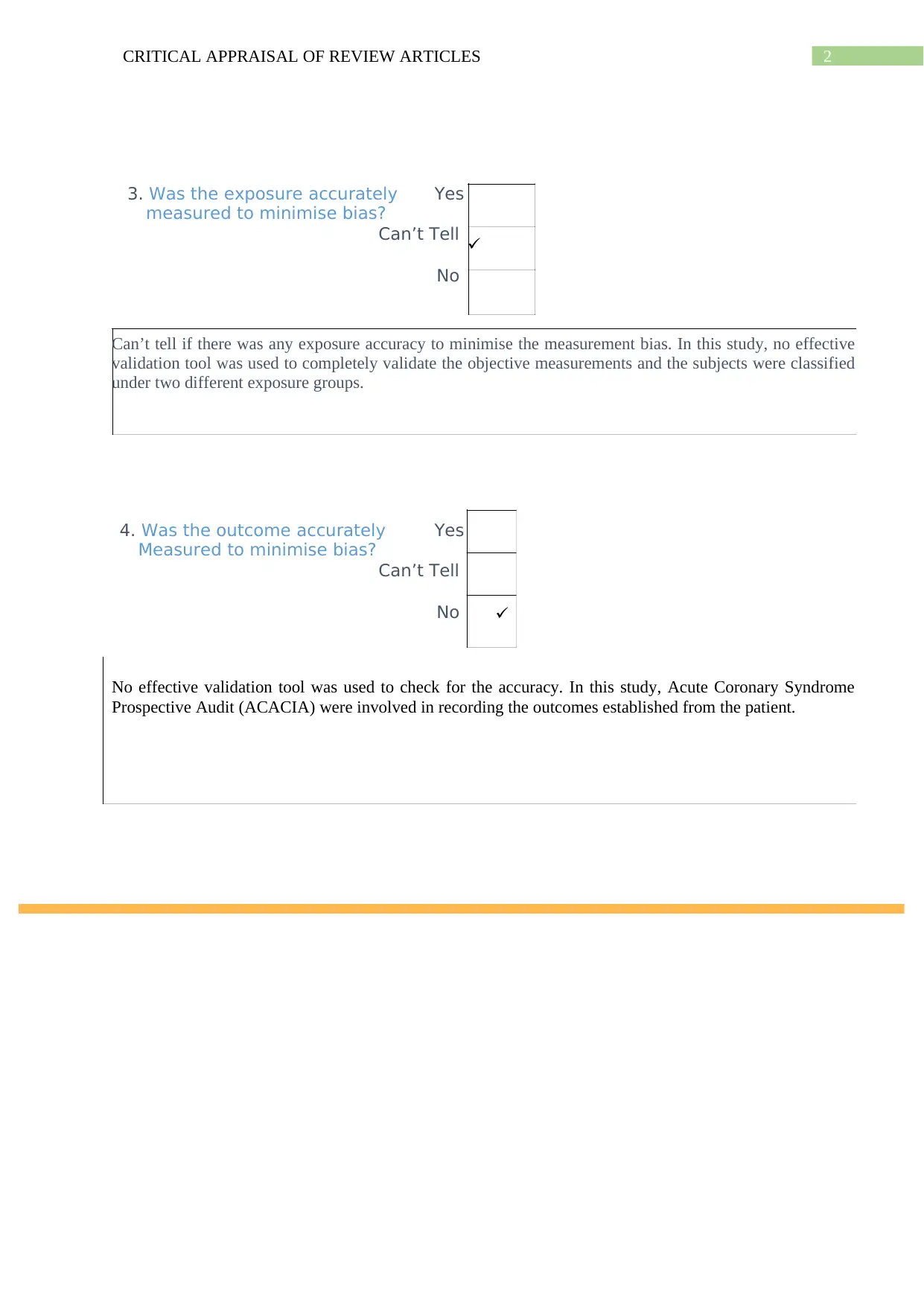
2CRITICAL APPRAISAL OF REVIEW ARTICLES
3. Was the exposure accurately Yes
measured to minimise bias?
Can’t Tell
No
Can’t tell if there was any exposure accuracy to minimise the measurement bias. In this study, no effective
validation tool was used to completely validate the objective measurements and the subjects were classified
under two different exposure groups.
4. Was the outcome accurately Yes
Measured to minimise bias?
Can’t Tell
No
No effective validation tool was used to check for the accuracy. In this study, Acute Coronary Syndrome
Prospective Audit (ACACIA) were involved in recording the outcomes established from the patient.
3. Was the exposure accurately Yes
measured to minimise bias?
Can’t Tell
No
Can’t tell if there was any exposure accuracy to minimise the measurement bias. In this study, no effective
validation tool was used to completely validate the objective measurements and the subjects were classified
under two different exposure groups.
4. Was the outcome accurately Yes
Measured to minimise bias?
Can’t Tell
No
No effective validation tool was used to check for the accuracy. In this study, Acute Coronary Syndrome
Prospective Audit (ACACIA) were involved in recording the outcomes established from the patient.
⊘ This is a preview!⊘
Do you want full access?
Subscribe today to unlock all pages.

Trusted by 1+ million students worldwide
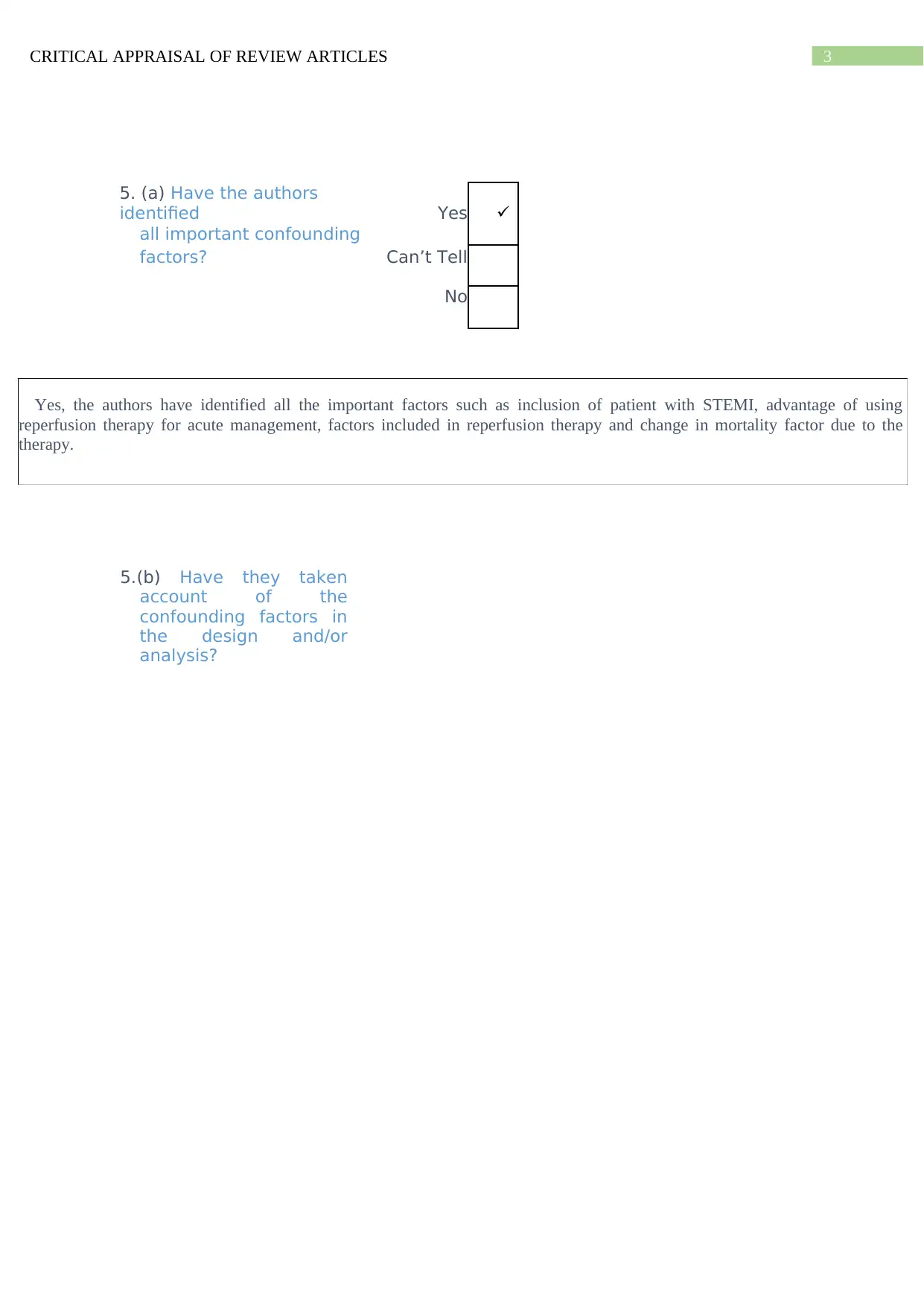
3CRITICAL APPRAISAL OF REVIEW ARTICLES
5. (a) Have the authors
identified Yes
all important confounding
factors? Can’t Tell
No
Yes, the authors have identified all the important factors such as inclusion of patient with STEMI, advantage of using
reperfusion therapy for acute management, factors included in reperfusion therapy and change in mortality factor due to the
therapy.
5.(b) Have they taken
account of the
confounding factors in
the design and/or
analysis?
5. (a) Have the authors
identified Yes
all important confounding
factors? Can’t Tell
No
Yes, the authors have identified all the important factors such as inclusion of patient with STEMI, advantage of using
reperfusion therapy for acute management, factors included in reperfusion therapy and change in mortality factor due to the
therapy.
5.(b) Have they taken
account of the
confounding factors in
the design and/or
analysis?
Paraphrase This Document
Need a fresh take? Get an instant paraphrase of this document with our AI Paraphraser

4CRITICAL APPRAISAL OF REVIEW ARTICLES
Yes
Can’t
Tell
No
Yes
Can’t
Tell
No

5CRITICAL APPRAISAL OF REVIEW ARTICLES
The researcher did consider the entire confounding factor necessary for the analysis of the study in order to estimate the necessary changes
in mortality rate and to determine the effect of reperfusion therapy in treatment of myocardial infraction.
6. (a) Was the follow up of Yes
subjects complete
enough?
Can’t
Tell
No
6. (b) Was the follow up of Yes
subjects long enough? Can’t
Tell
No
The researcher did consider the entire confounding factor necessary for the analysis of the study in order to estimate the necessary changes
in mortality rate and to determine the effect of reperfusion therapy in treatment of myocardial infraction.
6. (a) Was the follow up of Yes
subjects complete
enough?
Can’t
Tell
No
6. (b) Was the follow up of Yes
subjects long enough? Can’t
Tell
No
⊘ This is a preview!⊘
Do you want full access?
Subscribe today to unlock all pages.

Trusted by 1+ million students worldwide

6CRITICAL APPRAISAL OF REVIEW ARTICLES
Paraphrase This Document
Need a fresh take? Get an instant paraphrase of this document with our AI Paraphraser

7CRITICAL APPRAISAL OF REVIEW ARTICLES
In this study, only a observational design of approach was
considered with the aim to just confirm the robustness of already
used treatment effect. A more extensive study should have been
considered with improved data infrastructure in order to match the
clinical infrastructure
Section B: What are the results?
7. What are the results of this study?
The result stated that timely reperfusion therapy was
beneficial in reducing the mortality rate of the patient
suffering with myocardial infraction. The benefit of using
early reperfusion therapy was highlighted in the result stating
that no crucial difference in mortality rate was estimated in
the rural and metropolitan patients of Australia.
8.How precise are the results?
The result was precise in stating the advantages of reperfusion therapy for the
patients suffering with myocardial infraction but the outcome of the individuals
involved in this observational study was not mentioned precisely with no description
of the effect of treatment in those patients.
In this study, only a observational design of approach was
considered with the aim to just confirm the robustness of already
used treatment effect. A more extensive study should have been
considered with improved data infrastructure in order to match the
clinical infrastructure
Section B: What are the results?
7. What are the results of this study?
The result stated that timely reperfusion therapy was
beneficial in reducing the mortality rate of the patient
suffering with myocardial infraction. The benefit of using
early reperfusion therapy was highlighted in the result stating
that no crucial difference in mortality rate was estimated in
the rural and metropolitan patients of Australia.
8.How precise are the results?
The result was precise in stating the advantages of reperfusion therapy for the
patients suffering with myocardial infraction but the outcome of the individuals
involved in this observational study was not mentioned precisely with no description
of the effect of treatment in those patients.
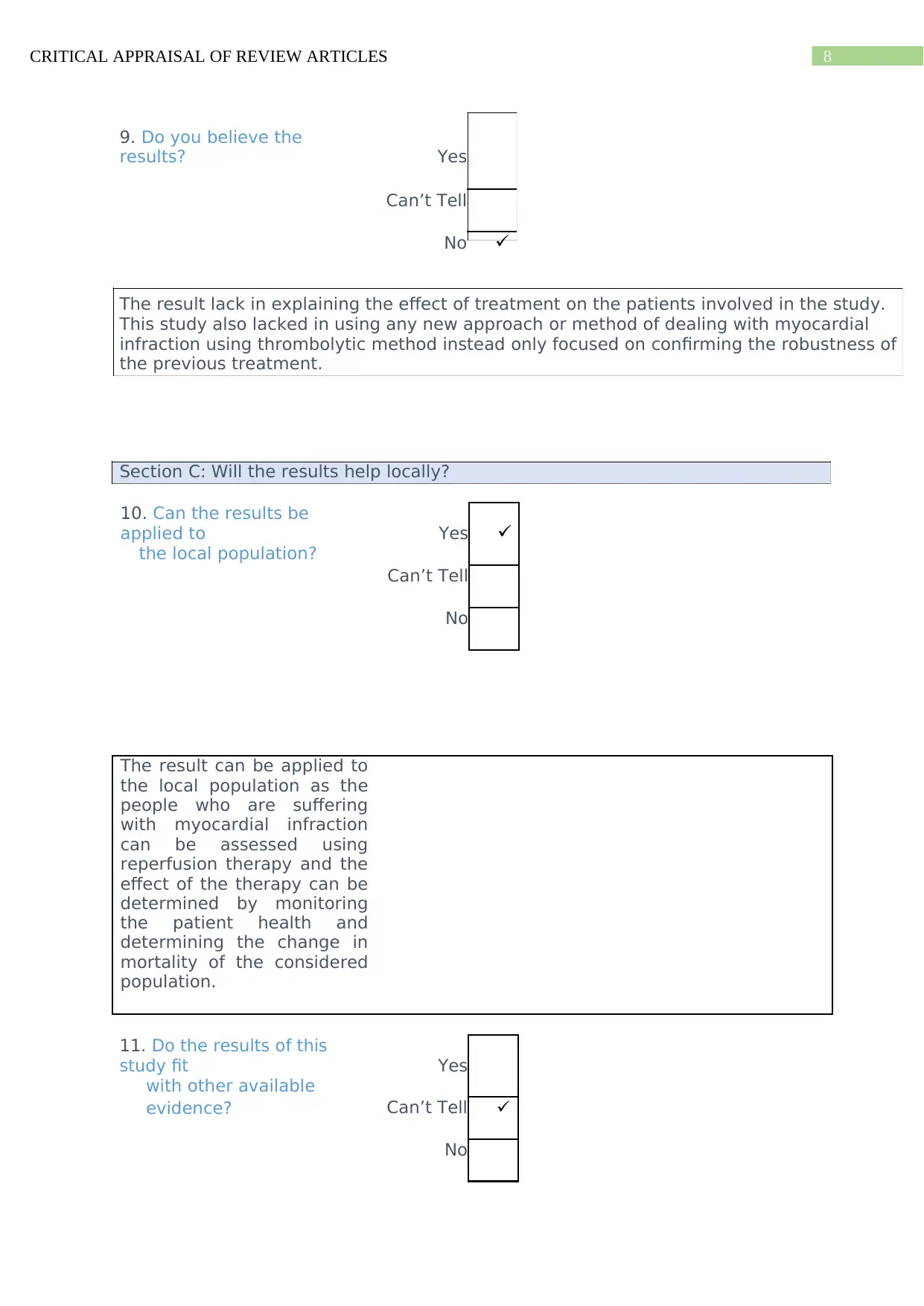
8CRITICAL APPRAISAL OF REVIEW ARTICLES
9. Do you believe the
results? Yes
Can’t Tell
No
The result lack in explaining the effect of treatment on the patients involved in the study.
This study also lacked in using any new approach or method of dealing with myocardial
infraction using thrombolytic method instead only focused on confirming the robustness of
the previous treatment.
Section C: Will the results help locally?
10. Can the results be
applied to Yes
the local population?
Can’t Tell
No
The result can be applied to
the local population as the
people who are suffering
with myocardial infraction
can be assessed using
reperfusion therapy and the
effect of the therapy can be
determined by monitoring
the patient health and
determining the change in
mortality of the considered
population.
11. Do the results of this
study fit Yes
with other available
evidence? Can’t Tell
No
9. Do you believe the
results? Yes
Can’t Tell
No
The result lack in explaining the effect of treatment on the patients involved in the study.
This study also lacked in using any new approach or method of dealing with myocardial
infraction using thrombolytic method instead only focused on confirming the robustness of
the previous treatment.
Section C: Will the results help locally?
10. Can the results be
applied to Yes
the local population?
Can’t Tell
No
The result can be applied to
the local population as the
people who are suffering
with myocardial infraction
can be assessed using
reperfusion therapy and the
effect of the therapy can be
determined by monitoring
the patient health and
determining the change in
mortality of the considered
population.
11. Do the results of this
study fit Yes
with other available
evidence? Can’t Tell
No
⊘ This is a preview!⊘
Do you want full access?
Subscribe today to unlock all pages.

Trusted by 1+ million students worldwide
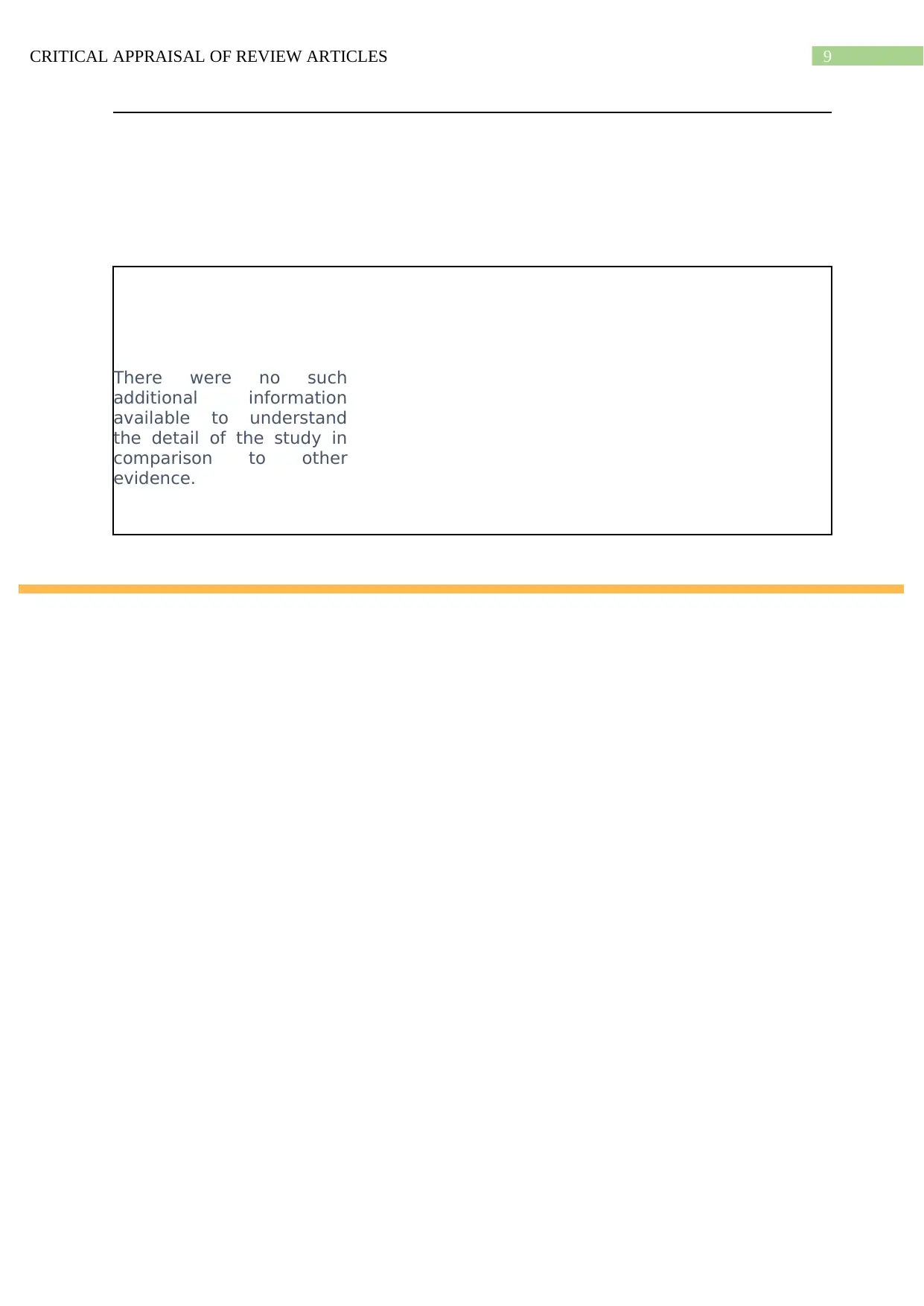
9CRITICAL APPRAISAL OF REVIEW ARTICLES
There were no such
additional information
available to understand
the detail of the study in
comparison to other
evidence.
There were no such
additional information
available to understand
the detail of the study in
comparison to other
evidence.
Paraphrase This Document
Need a fresh take? Get an instant paraphrase of this document with our AI Paraphraser
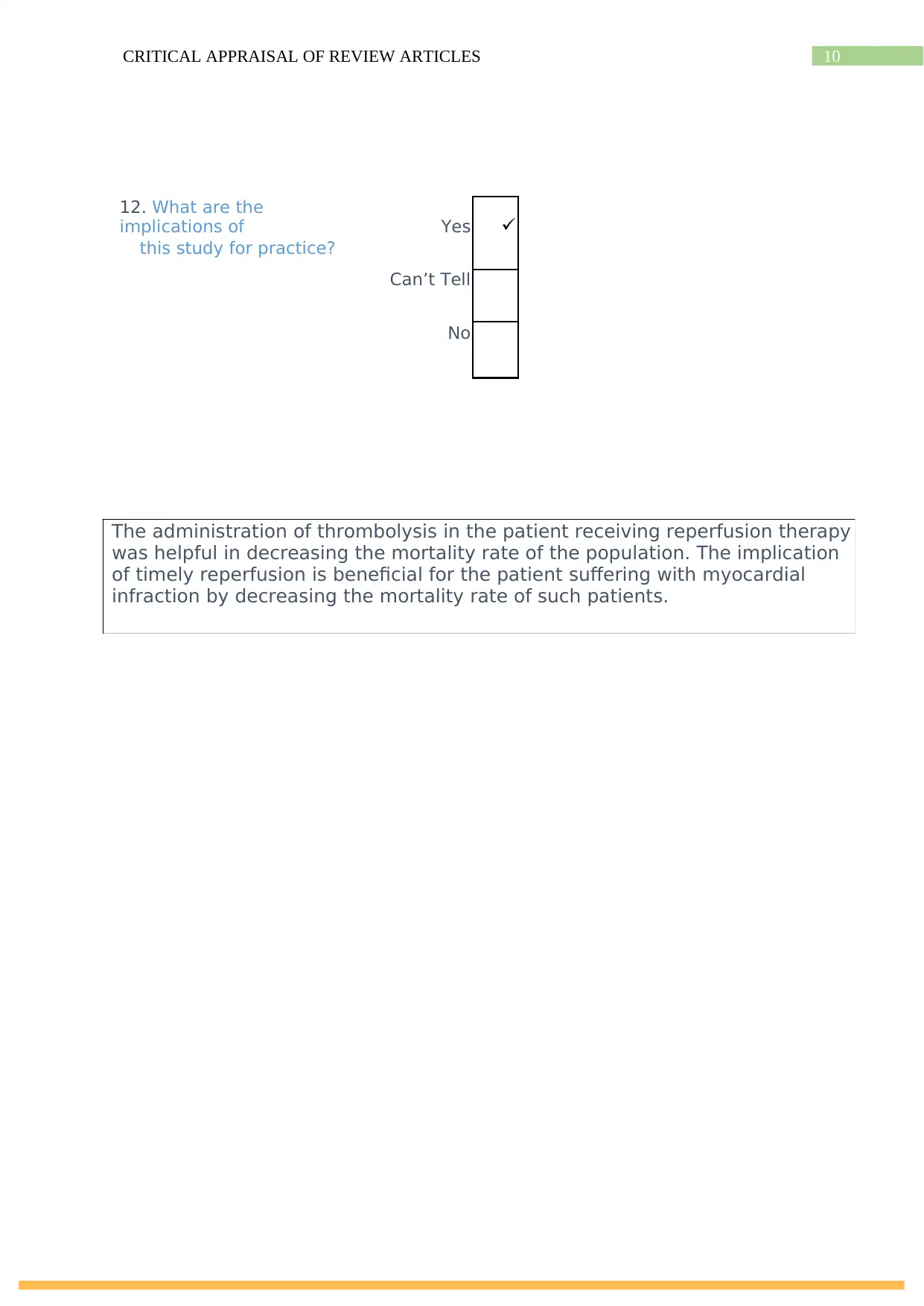
10CRITICAL APPRAISAL OF REVIEW ARTICLES
12. What are the
implications of Yes
this study for practice?
Can’t Tell
No
The administration of thrombolysis in the patient receiving reperfusion therapy
was helpful in decreasing the mortality rate of the population. The implication
of timely reperfusion is beneficial for the patient suffering with myocardial
infraction by decreasing the mortality rate of such patients.
12. What are the
implications of Yes
this study for practice?
Can’t Tell
No
The administration of thrombolysis in the patient receiving reperfusion therapy
was helpful in decreasing the mortality rate of the population. The implication
of timely reperfusion is beneficial for the patient suffering with myocardial
infraction by decreasing the mortality rate of such patients.

11CRITICAL APPRAISAL OF REVIEW ARTICLES
Article 2:
Paper for appraisal and reference: Armstrong, P. W., Gershlick, A. H., Goldstein, P., Wilcox, R.,
Danays, T., Lambert, Y., ... & Carvalho, A. C. (2013). Fibrinolysis or primary PCI in ST-segment
elevation myocardial infarction. New England Journal of Medicine, 368(15), 1379-1387.
Section A: Are the results of the study valid?
1. Did the study address a
clearly Yes
focused issue? Can’t Tell
No
Yes, the study did focus on the issue of ST- segment elevation myocardial infraction
(STEMI). The concept of using prehospital fibrinolysis with coronary angiography for
increasing the effectiveness of the treatment of the patient suffering from the
disease.
2. Was the cohort recruited
in Yes
an acceptable way?
Can’t Tell
No
Yes, the cohort study was conducted in an acceptable way. The study was more of a proof-
of-concept study with the record of patients who underwent randomization and follow up
with informed consent.
Article 2:
Paper for appraisal and reference: Armstrong, P. W., Gershlick, A. H., Goldstein, P., Wilcox, R.,
Danays, T., Lambert, Y., ... & Carvalho, A. C. (2013). Fibrinolysis or primary PCI in ST-segment
elevation myocardial infarction. New England Journal of Medicine, 368(15), 1379-1387.
Section A: Are the results of the study valid?
1. Did the study address a
clearly Yes
focused issue? Can’t Tell
No
Yes, the study did focus on the issue of ST- segment elevation myocardial infraction
(STEMI). The concept of using prehospital fibrinolysis with coronary angiography for
increasing the effectiveness of the treatment of the patient suffering from the
disease.
2. Was the cohort recruited
in Yes
an acceptable way?
Can’t Tell
No
Yes, the cohort study was conducted in an acceptable way. The study was more of a proof-
of-concept study with the record of patients who underwent randomization and follow up
with informed consent.
⊘ This is a preview!⊘
Do you want full access?
Subscribe today to unlock all pages.

Trusted by 1+ million students worldwide
1 out of 29
Related Documents
Your All-in-One AI-Powered Toolkit for Academic Success.
+13062052269
info@desklib.com
Available 24*7 on WhatsApp / Email
![[object Object]](/_next/static/media/star-bottom.7253800d.svg)
Unlock your academic potential
Copyright © 2020–2025 A2Z Services. All Rights Reserved. Developed and managed by ZUCOL.





